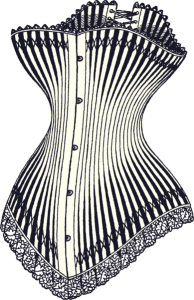 I have a habit for corsets. Not an addiction, mind you, I could stop buying them anytime. I just don’t want to. I enjoy the way they make my figure look, the way they tie me to a long line of feminine beauty. I enjoy the mystique, the titillation, the subtle sexuality. The not so subtle idea that by lacing myself into some thing I’m seen as giving up power, becoming submissive, when really I gain it, enjoying the way my corset forces people to react.
I have a habit for corsets. Not an addiction, mind you, I could stop buying them anytime. I just don’t want to. I enjoy the way they make my figure look, the way they tie me to a long line of feminine beauty. I enjoy the mystique, the titillation, the subtle sexuality. The not so subtle idea that by lacing myself into some thing I’m seen as giving up power, becoming submissive, when really I gain it, enjoying the way my corset forces people to react.
Corsetry comes with a culture. The debates rage from genteel to frenzied. Tell an under-the-bust fan that she should be in an over-the-bust and you risk a dirty look. Tell a waist-trainer he’s as bad as a bulimic and you risk a black eye.
What’s that you say? You don’t know what any of those words mean? You don’t even know the difference between spiral steel* and spring steel? But everyone in the corset community does! Just like everyone who reads urban fantasy knows that werewolves hurt when they shift.
Or do they? Being part of a community, the corset community or a critique group, can make writers feel their work is more accessible than it really is. Phrases not found in everyday speech, comparisons to unknown things, and briefly sketched explanations require your readers to have some prior knowledge. For fans of your genre or people who’ve read your work before that’s not a problem, but do you want to exclude everyone else?
I was surprised when a colleague didn’t know what the word telekinesis meant, I’d be shocked to find someone who didn’t know that vampires hated sunlight (certain sparkling clans excepted). That doesn’t mean those people don’t exist, and I want them to be able to read and enjoy my book as much as the people who know those things. A reference to the difference between a hootenanny and a shindig makes an urban fantasy fan smile but doesn’t perplex the average mundane reader. Referencing Anita Blake’s love life or Bob the Skull excludes people unfamiliar with the greats in our genre. Worse that kind of writing tends to be a short cut, the worst kind of telling instead of showing.
When I look back at my first manuscript I see a plethora of these comparisons. Characters look like someone from a TV show, fashion references the popular actress of the time, and work allusions to other works abound. In my current work, I’ve grown beyond that, I can say a couch is battered, stained, and infused with the smell of coffee instead of referencing the couch on Friends, hoping my readers still remember that show. It’s harder to be accessible, but if it means more readers it’s work I’m willing to do.
* For those of you who are curious, spiral steel is made up of a series of interlocking steel loops, while spring steel is a single straight piece of steel. Handy image of spiral steel from Wikipedia: